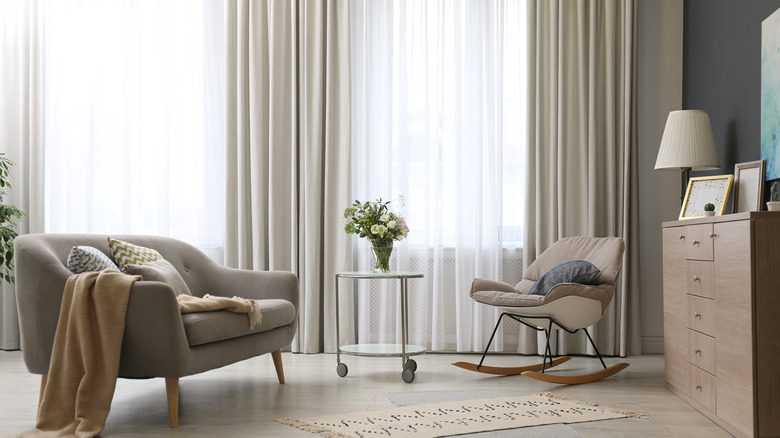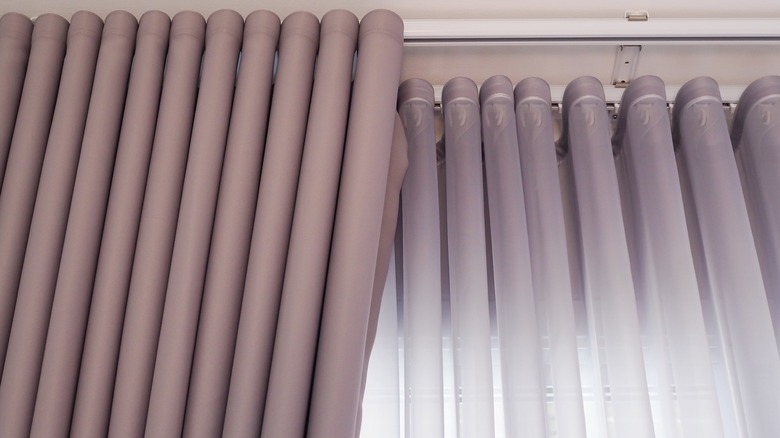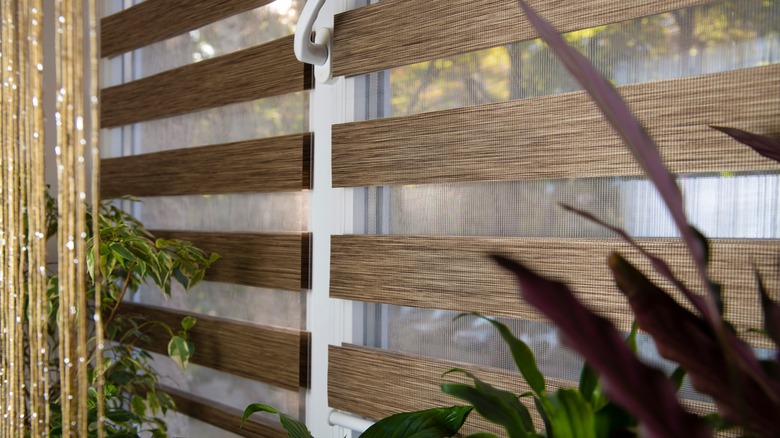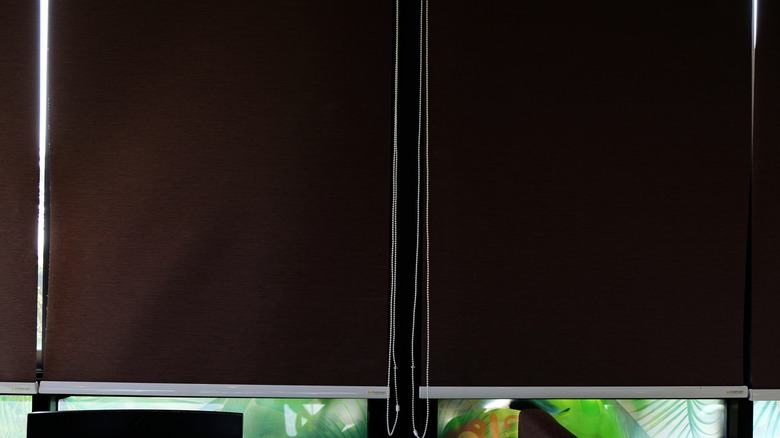The Best Type Of Curtains For Your Living Room
No matter its size or shape, the living room is the place where friends and family gather, so most of us aim to make it as appealing as possible. Our best furniture is usually found here, as are our favorite pieces of art, lamps, carpets, and more. There is no shortage of ideas to inspire homey and inviting living rooms designed for maximum comfort and appeal. The most charming details are like accessories added to a great outfit, and curtains and window treatments may be the most important details of all.
The best curtains for your living room are the ones that offer the best solutions given your need for privacy, energy efficiency, and let's not forget your budget. Blinds Galore notes that while you could choose from the hundreds of options online, depending on the vibe you want to convey, plus the size of your windows, you may want to explore custom window treatments. Custom-fitted curtains and blinds are usually pricier but make a bigger visual impact in the living room.
Curtain considerations
According to online retailer Drapes Place, homeowners should consider the style of their living room. Is it rustic? Elegant? Minimalist? Think about the room's key pieces. Are they traditional or modern or a mix of both? Then think about the mood of the room. A white-on-white palette can feel somewhat cold. An all-gray color scheme, while recently popular, has morphed into an environment that's warmer and more inviting by adding off-white shades, light beige hues, and more textured surfaces in furniture, pillows, and rugs. Curtains should complement the space, adding to its comfort and ambiance.
As JC Penney points out, don't just cover the window itself but add extra material above and on either side of the panes for a fuller look. Don't stretch material over the window like a person wearing a shirt or dress that's too small. The more material you hang, the more luxurious your room looks. Additionally, curtains come in standard lengths and widths (unless they are custom-made). For living rooms the standard style is for curtains to hang from the top of the window or just above the window frame, flowing to the floor.
Material
The thickness or weight of the curtain fabric makes a big difference in the feel and mood of your living room. Billowy sheers may be perfect for a warm, windy evening in July but are mostly impractical for a sleety January and ridiculous if you require privacy. Thick drapes with multiple folds and layers may look overly heavy in a typical living room. In between the light and the heavy are opaque curtains, which offer a modicum of privacy when shut and a shot of color when open.
Overstock offers practical advice on choosing the fabric for your curtains. Traditional materials such as silk or velvet drape beautifully, but they are also the most expensive to maintain and also to clean. More practical options include linen, cotton, and blends of the two, which are usually washable at home and still lend an air of stylishness. Polyester and other blends are affordable, convenient, and practical, and come in an extensive variety of patterns and colors.
Layering
One way to get the maximum impact from your living room curtains is to layer patterns and colors. Mixing and matching fluid curtains and solid blinds is also a possibility. Centurian Window Fashions suggests that if your living room is traditionally styled, a subtle pattern in similar shades adds visual interest. You can also change the look of the living room by adding a bold shot of color to an otherwise neutral palette. Similarly, if your furniture and rugs are in mostly bright colors or deep jewel tones, white or off-white curtains could work as a contrasting feature, balancing out the bolder colors.
When mixing blinds and curtains, watch for combinations that appear hard or soft on your windows. Blinds.com explains that depending on the blind material (wood, metal, or fabric,) the same curtain mixed with each texture takes on a different appearance and lends a different air to the living room. Slatted wood blinds, for example, are very traditional and could weigh down a space decorated in all whites and light grays, while Roman shades in canvas or linen might be a better choice for a softer feel. Remember too, that blinds can give a horizontal or vertical visual to the room, layered or not. Mixing patterns can be tricky, so read up on do's and don'ts before your living room turns into a disorganized riot of color, pattern, and texture.
Blackout curtains
You've probably heard or read about the convenience and health benefits of blackout curtains for bedrooms. TriHealth notes that blackout curtains are beneficial in getting a good night's rest. By blocking out external light, they help the body get to sleep and stay asleep. But what about the living room? You might want blackout curtains for complete privacy, to block out the neighbors' view of your interior, or the glare from streetlights.
However, most people want at least some natural light in their living room. A better way to go may be room darkening curtains, which are a softer alternative. Zebra Blinds explains that darkening curtains dim natural light, which prevents furniture and rugs from fading, and also covers windows so the interior room bathes in a diffused glow. Additionally, blackout or darkening curtains improve energy efficiency — they affect a room's temperature, helping to keep out cold drafts in chilly climates, or cooling interior spaces in the hottest environments by blocking out direct sunlight.
Hardware and finishing touches
Just as window treatments help finish a room's look, hardware and accessories (scarves and tiebacks) help finish the curtain's look. Hardware can include rods and hooks, rings, finials or end caps, and more. According to Drapery Rods Direct, there are a number of things to think about when hanging drapes or blinds.
Are the curtains going to remain stationary? If you have extra-large windows, you need heavier hardware to support the volume of the material hanging down. If the curtains are going to open and shut regularly, be sure to use a system — manual or mechanical that both supports the material but also allows the curtains to move back and forth freely. Grommet drapery panels are a newer kind of curtain that allows the material to sweep along the curtain rod without hooks or rings and offer an easy way to adjust your curtains as needed. Just as curtains should match or compliment the living room's décor, the hardware and accents should do the same for the curtains.





